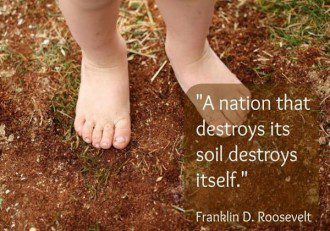8th November 2015
Guest Writer for Wake Up World
Robert Kremer Ph.D, co-author of the book Principles in Weed Management, is a certified soil scientist and professor of Soil Microbiology at the University of Missouri. He recently retired from the United States Department of Agriculture (USDA) where he worked as a microbiologist for 32 years. He’s conducted research since 1997 on genetically engineered (GE) crops.
In this interview he reveals how GE crops and glyphosate impact soil ecology and biology.
[pro_ad_display_adzone id=”110028″]
Roundup Causes Buildup of Pathogens on Root Systems
Prior to the advent of genetically engineered (GE) crops, his research projects were focused on plant and microorganism interactions in the soil.
It was well-known that one of the secondary mechanisms of actions of glyphosate was that it tended to cause the plant to become infected with opportunistic soil pathogens.
When the first transgenic plants came out around 1996, Kremer’s team decided to investigate whether the use of glyphosate on genetically engineered (GE) soybeans might attract certain soil pathogens like Fusarium.
While often considered as a pathogen, several species in the Fusarium genus can be beneficial in the environment, as they mediate decomposition of organic substances in the soil.
Other species are opportunistic, and if the conditions are just right on a plant, they will attack the plant and become pathogenic (infectious) under those circumstances.
What they found was that after application of Roundup (the active ingredient of which is glyphosate), there was always a buildup of soilborne Fusarium on soybean and corn root systems during the season.
“When you see that amount of Fusarium building up on a root system, you would suspect there would be a potential for disease development under ideal conditions,” Kremer says.
“As it turns out with soybean and corn, we identified four or five major species. We found actual disease-causing pathogenic species in only 10 to 20 percent of root samples that were assayed.
One is the causal agent of sudden death syndrome in soybean, which causes a wilt and root rot, primarily under wet soil conditions.
But interestingly, while we thought we would consistently detect this pathogen on roots of soybean treated with glyphosate, it was never a dominant species found in field soil or on the roots season after season.
What we did find were many other Fusarium species, some of which could be pathogenic or cause a disease under certain conditions.
Our main conclusion from that was that these soybean varieties, due to their genetic modification and glyphosate treatment, provided a soil environment very conducive for proliferation of Fusarium, thereby setting up a good potential for disease to rapidly develop if the conditions were optimal for that to happen.
This is because the inocula needed for disease progression is already built up on the roots and ready to infect when conditions allow whereas non-transgenic soybean did not exhibit that disease potential.”
How Glyphosate Disrupts Plant Growth
As described by Kremer, glyphosate’s primary mode of action is that it shuts down amino acid synthesis, followed by inhibition of protein synthesis necessary for plant growth.
A complementary mode of action is that when this happens, it causes the plant to be more susceptible to the microbes (and any pathogens) in the soil.
The reason for this is because the amino acids are also building blocks for other compounds that have defensive functions against soil pathogens — such as Fusarium. As a result, the plant becomes more susceptible to attack and infection by many microorganisms in the soil.
Glyphosate also acts as a mineral chelator, and minerals such as zinc, copper, and manganese which are essential cofactors in many plant and human enzymes.
Chelating or removing these minerals from the plants is largely responsible for impairing their protein synthesis as the enzymes involved in syntheses require the minerals to function. This then opens the plant up to attack.
Glyphosate Is Systemic, and That’s Part of the Problem
We often think of glyphosate as just another herbicide being applied topically, but it’s important to realize that one of the properties of glyphosate is that when it enters a plant, it becomes systemic, and cannot be washed off like many other herbicides.1
It becomes integrated into every cell in the plant, especially the faster growing cells. As explained by Kremer:
“It is translocated throughout the plant, primarily towards growing points of the plant, meristematic tissue, and one of the most active growing points in the plant are young root tips.
A lot of the glyphosate applied to the plant passes through the plant. It goes to meristems and to developing seeds. But a lot of it is transported to the roots, and much of that passes through the root, into the soil…
When glyphosate is released there… it will contact nutrients that are in the soil solution and chelate or immobilize them, tying them up, and making them unavailable to the plant.
The nutrients also become unavailable to beneficial microorganisms that are in the rhizosphere. They are not able to acquire those micronutrients at all. You have a two-way effect here.
You have an effect on the plant where it can’t take up these essential nutrients to mediate the reactions by the enzymes, where those micronutrients are needed.
Also, the microorganisms that have enzymes to those of plants, cannot accomplish their metabolism either.”
Once Bound by Glyphosate, Micronutrients Are Also Made Unavailable to Your Body
Interestingly, if you do a tissue analysis of a GE plant looking for micronutrients, the test may reveal that there are sufficient amounts of manganese and other minerals present. However, the tissue analysis will not tell you how much of this manganese is tied up and therefore made unavailable by the glyphosate in the plant…
Moreover, if the minerals are bound to glyphosate in the plant, there’s no way for your body to dissociate that bond to make the nutrients available when you eat it. Instead, those minerals will simply be excreted back out, or worse, stored in your body right along with the glyphosate.
Making matters even worse, glyphosate formulations such as Roundup are synergistically even more toxic than glyphosate itself. For example, surfactant chemicals disrupt the cellular membranes in the plant, making uptake of other chemicals like glyphosate a lot easier, and hence riskier.
“With some of the microorganisms we found, [the surfactants] will interfere with cellular membrane lipids. For example, in some of these microorganisms, it will interfere with soil enzyme activities that have beneficial effects in some biological processes. There’s a lot more that we need to learn about this, because there are many additives in the formulation of Roundup, surfactants being just one of those compounds.”
The Drawbacks of ‘Burndown Application’ of Glyphosate in No-Till Farming
Some sustainable agriculture no-till farmers use of Roundup in what’s called a “burndown application” in the spring to kill off any weeds and vegetation in the field prior to planting. No-till is a very beneficial practice, as tilling the soil decimates many beneficial soil microbes, especially the mycorrhizal fungi, and it contributes to the massive loss of topsoil. However, sterilizing the soil in this manner has significant drawbacks in the long-term, and if a farmer is not careful, it can result in a failed crop.
As explained by Kremer:
“The burndown is often used as a pre-treatment for no-till. When that happens, any vegetation is going to get a flush of microbial activity in the root zone. This is why it’s recommended farmers wait at least a week or 10 days in order for that flush of potential pathogenic microbes in the soil to peak and die down.
Then you can plant your crop without the risk of this unbalanced microbial community attacking the seedling of your new crop. That’s a real problem. I’ve known personally of some farmers who can’t wait. They plant right after burndown, and they pay for it with the appearance of their crops later, because it does affect their early growth.”
You can think of this as being similar to the clinical application of an antibiotic for a serious disease. In this case, the glyphosate is not applied to treat a disease; it’s just an agricultural process. Nevertheless, it’s killing the soil microbiome just as an antibiotic kills the microbiome in your gut and has nearly identical adverse side effects. It decreases the soil’s ability to nourish the plants and resist pests.
The residual activity — in both cases — can last for quite a while, not just a few days. Sure, the bacterial balance will begin to improve, but it still leaves an unbalanced microbial community in its wake. And there are many components of the microbial community that actually thrive with glyphosate. Fusarium is one of them, and most of them are not beneficial.
“Another one that tolerates glyphosates is Agrobacterium,” Kremer says. “Some of the Agrobacterium species can be very important disease agents. Those two organisms kind of bring this full circle. They not only tolerate glyphosate, but they are also what we call manganese oxidizers; they will actually tie up manganese in the soil.
So not only do you have glyphosate tying up [manganese], but you have this increase in organisms that will also tie-up manganese because it oxidizes it to an unavailable form. This is one of the other outcomes of using glyphosate… Now, it’s interesting that glyphosate is used a lot in perennial crops, such as vineyards, orchards, and almond production.
I believe it’s fair to note that when we use a lot of glyphosate in those systems for vegetation control, what is happening is that when the glyphosate is released through the roots in those systems, glyphosate can then be taken up by some of those desirable plants, such as grapevines and trees, which are not Roundup-resistant.
The next thing you know, we will have some root dieback in the topsoil, or we have this abnormal growth that we’ve seen in grapes. Then they wonder why they’re having production problems. The overuse of glyphosate in some of these perennial systems is a very serious problem.”
GMOs Have Led to Increase in Herbicides and Other Agricultural Chemicals
One justification the chemical technology industry used to promote and support the use of GE crops is that they would decrease the need for pesticides. In reality, weed resistance to the chemical has led to a steady increase in use. An estimated 60 million acres of farmland are now overrun with glyphosate resistant superweeds.
Even though farmers rotate between growing corn and soybeans, most grow Roundup Ready versions of both crops. In other words, these crops tolerate Roundup applications for weed control. So even though the crop changes, you have a continuous application of Roundup year after year. Often, that is preceded by Roundup in a burndown treatment, and then you have application of Roundup during the season, probably more than once.
“Instead of going to different crops that are not Roundup Ready, the thought was, ‘Well, let’s just engineer the crop to resist other herbicides that can kill out the Roundup-resistant weeds.’ Yes, [we] will have crops that are resistant to at least two or three different herbicides, including glyphosate. The other herbicides may be 2,4-dichlorophenoxyacetic acid (2,4-D) and dicamba. These are to take out the glyphosate-resistant weeds.
But we already know that in 2,4-D and dicamba, there are weeds that have been shown to be resistant to that class of compounds as well. It’s just a matter of time before those weeds will be resistant to maybe three different herbicides. We know that there are some weeds that are resistant to five different herbicides. The writing is on the wall that this is going to happen,” Kremer says.
More chemicals are also being used to control diseases associated with soybeans and corn. When the first transgenic soybeans came out, the seed was never treated with insecticides or fungicides. Now you can’t buy Roundup Ready seed without having it treated with at least one insecticide and a fungicide to control anticipated pests. So farmers cannot buy “clean” seeds anymore; certainly not from Monsanto. And this cocktail of chemicals is eventually transferred to the plant, and consumed by livestock and humans.
To Regenerate Soil, We Need a New Agricultural System
According to Kremer, after years of growing GE corn and soybeans, many farmers are now noticing a decline in productivity — which again is the exact converse of Monsanto’s promises. And the reason for this decline is directly linked with declining soil health. As noted by Kremer:
“What has happened, primarily with industrial agriculture, is that using glyphosate and transgenic [plant] varieties, and all the chemical fertilizers that we’re putting out there, we’ve decreased soil organic matter, which is the key to soil health, because it affects all the properties of the soil.”
As you would expect, many nutrients, especially the micronutrient levels, have also decreased in our food. As a result of these adverse ramifications, increasing numbers of farmers are ready for change, and many now want to revert back to non-GMO crops. This is certainly part of the answer, but it’s not the whole solution. Soil must be actively regenerated with appropriate processes. It’s not enough to just switch to non-GMO seeds.
Using cover crops is an important part of the solution, as it helps build up organic matter in the soil, breaks up compactions, and allows for better water and air infiltration below the surface of the soil, which helps beneficial microorganisms thrive. Incorporating holistic herd management is another key component.
“I think there is a lot of opportunity for that,” Dr. Kremer says. “I know some farmers who are already doing that. And, if we could have the grazers on the land to process that vegetative material and deposit the organic matter around, that would go a long way to reviving and remediating these soils. The biggest problem is that we have this separation of the various types of agriculture.
Most of the confined animal feeding operations (CAFOs) are out West, and we ship all our grain out there. We’re taking the nutrients away from here, and they have these huge of piles of manure in the West [that need to be in the soil]… I think the demand for meat that is not fed with GE crops is growing, and I believe we’re going to see more local processors and maybe local feeding operations where we have grass-fed cattle and grass-fed hogs.
We may be seeing a turn towards that, because most of those large feeding operations obviously are using the commodity corn and soybean, which are Roundup Ready. I think there’s going to be a point where we will see this change come around. We’re going to have a complete, sustainable system with livestock and the feed grains being grown in the same landscape.”
Do You Have a Victory Garden?
The idea of planting Victory Gardens goes back to World War I and II, and was advertised as a way for patriots to make a difference on the home front. Planting these gardens helped the citizens combat food shortages by supplying themselves and their neighbors with fresh produce.
Planting your own Victory Garden can go a long way toward healthier eating, and in the long run, it can provide incentive for industry-wide change, and a return to a diet of real food, for everyone, everywhere. A great way to get started on your own is by sprouting. They may be small, but sprouts are packed with nutrition and best of all, they’re easy and inexpensive to grow.
Article sources:
Previous articles by Dr. Joseph Mercola:
- Scientific Review Shows Fluoridation Does Not Prevent Cavities
- Scientific Links Between Processed Foods and Depression
- The Aspartame End Game… and What’s Next
- Neil Young, Pope Francis and 100,000 Beekeepers Take a Stand Against Toxic Agriculture
- The Surprising Ways in Which Fast Food and its Packaging Harms Your Health
- How Sugar Harms Your Brain Health and Drives Alzheimer’s Epidemic
- The Health Benefits of Intermittent Fasting
- Sleep Loss May Cause Brain Damage and Accelerate Onset of Alzheimer’s, Two New Studies Show
- Can a Hug a Day Keep Infection Away?
- The Fluoride Deception Continues as US Government Ignores Fluoride’s Role as an Endocrine Disruptor
- Magnesium: An Invisible Deficiency That Could Be Harming Your Health
About the author:
 Born and raised in the inner city of Chicago, IL, Dr. Joseph Mercola is an osteopathic physician trained in both traditional and natural medicine. Board-certified in family medicine, Dr. Mercola served as the chairman of the family medicine department at St. Alexius Medical Center for five years, and in 2012 was granted fellowship status by the American College of Nutrition (ACN).
Born and raised in the inner city of Chicago, IL, Dr. Joseph Mercola is an osteopathic physician trained in both traditional and natural medicine. Board-certified in family medicine, Dr. Mercola served as the chairman of the family medicine department at St. Alexius Medical Center for five years, and in 2012 was granted fellowship status by the American College of Nutrition (ACN).
While in practice in the late 80s, Dr. Mercola realized the drugs he was prescribing to chronically ill patients were not working. By the early 90s, he began exploring the world of natural medicine, and soon changed the way he practiced medicine.
In 1997 Dr. Mercola founded www.Mercola.com, which is now routinely among the top 10 health sites on the internet. His passion is to transform the traditional medical paradigm in the United States. “The existing medical establishment is responsible for killing and permanently injuring millions of Americans… You want practical health solutions without the hype, and that’s what I offer.”
Visit www.Mercola.com for more information, or read Dr. Mercola’s full bio and résumé here.
[pro_ad_display_adzone id=”110027″]










